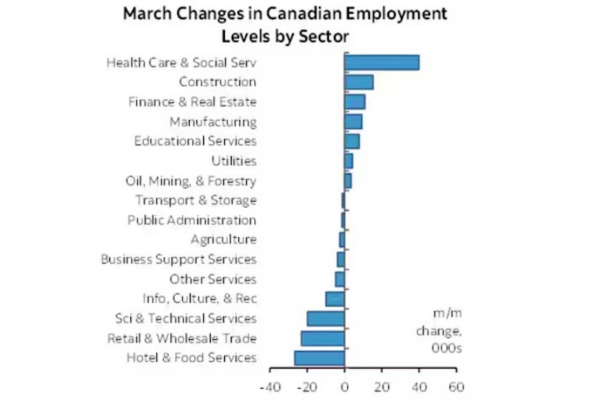
The latest Canada job market report shows that the unemployment rate rose to 6.1 percent in March, 2024 as the population increased by 91,000 month-over-month and more people searched for work.
According to Statistics Canada, the unemployment rate was 5.8 percent in February, the most significant jump since the summer of 2022.
Advertisement:
StatCan’s newest labour force survey also revealed a minimal change in employment in March. The economy lost 2,200 jobs after posting modest gains in the first few months of 2024.
Job Market Report Shows a Big Drop in Self-employment Numbers
Advertisement:
However, while the Canadian job market was flat in March, Scotiabank Vice-President and Head of Capital Markets Economics Derek Holt said the survey’s “underlying details” were better.
Holt points out that self-employment drove the job market weakness, with a 29,000 drop. That drop offset a 27,000 gain in payroll jobs (split between a 15,000 rise in private sector payrolls and a 12,000 rise in public sector payrolls).
Canadian Jobs Breakdown
| PROVINCE | M/M |
|---|---|
| Quebec | -18.0k |
| Saskatchewan | -6.0k |
| Manitoba | -4.3k |
| Alberta | -3.2k |
| New Brunswick | -1.7k |
| Nova Scotia | -1.5k |
| Prince Edward Island | -0.1k |
| Newfoundland & Labrador | 0.0k |
| British Columbia | +6.6k |
| Ontario | +26.1k |
| EMPLOYMENT TYPE | M/M |
| Full Time | -0.7k |
| Part Time | -1.6k |
| Public Sector | +11.9k |
| Private Sector | +15.2k |
| Self Employed | -29.3k |
“Self-employed jobs are valuable in Canada,” said Holt, “but the lack of any means to verify (the self-employed) category lends caution. I’m more impressed by the payroll gain.”
Related Posts:
Working in Canada | A Guide to Land Your Dream Job!
Employment Services Help Newcomers Work in Canada
Advertisement:
Canada Job Bank | Your Vital Research Tool
Canadian Youth Hit Hard in March
Holt also noted that youth employment was the most brutal hit in the labour market.
In March, jobs fell by 28,000 among those aged 15 to 24. The jobless rate for that age group jumped to 12.6 percent.
That’s the highest since September 2016, outside of 2020 and 2021.
Holt said that while youth employment is essential, “the greater economic impact, including ties to the housing and consumer markets, always comes more from the (25 years and older) category.”
The temporary workers category of immigration, which has surged over the past few years, left fewer openings for youths to fill in terms of seasonal March break-related employment, said Holt.
He added that what happens to the youth job category for the remainder of 2024 partly depends on whether the federal government successfully achieves its new targets for temporary workers.
Later this year, the Canadian government plans to cap the number of new temporary residents it will accept and reduce the number of workers in certain sectors.
Canada plans to lower the number of temporary resident arrivals it accepts.
Starting in September 2024, the federal government will reduce the maximum limit of temporary residents to 5 percent of the population through 2027. Temporary residents currently make up 6.2 percent of the total population.
Employment Rose in Construction
The latest Canada job market report revealed that job losses in March occurred in the accommodation and food services sector, followed by wholesale and retail trade and professional, scientific and technical services.

Employment rose in four industries in March, with the healthcare and social assistance sectors leading the way.
In the construction sector, employment rose by 15,000 (1.0 percent) jobs in March, little changed from March 2023.
Statistics Canada says the rise in the jobless rate was driven by an increase of 60,000 people searching for work or temporarily laid off.
Rise in Wage Growth Continues
The country’s total number of unemployed people stood at 1.3 million last month, an increase of nearly 250,000 compared with a year ago.
Despite weaker labour market conditions, wage growth increased, with average hourly wages rising 5.1 percent annually.
As for the 91,000 rise in population growth, Holt observed that this “will fan concern that Canada is not generating enough jobs in relation to the immigration surge.”
“I’ve been saying for ages that Canada’s economy cannot absorb this magnitude of immigration quickly,” said Holt.
Record Population Growth Continues
Year over year, Canada’s population has grown by over one million people.
January and February 2024 saw the strongest back-to-back population growth in Canadian history.
Canada is on track to settle (or exceed) 485,000 newcomers in 2024 and 500,000 in 2025.
However, newcomers account for almost all growth in Canada as the population ages more quickly because of lower fertility rates and longer life expectancy.
“Slowing non-permanent resident arrivals will make the Canadian population older and make the impact of the ongoing wave of baby boomer retirements somewhat steeper,” warns RBC’s Nathan Janzen.
More People are Looking for Work
However, said Janzen, “slower population growth could ease price pressures in some pockets of the economy where supply has been slow to adjust to increased demand, particularly for housing.”
The increase in the jobless rate in March was also caused by an increase of 60,000 people looking for work or temporarily laid off.
Canada’s total number of unemployed was 1.3 million in March, an increase of nearly 250,000 compared with March 2022.
Canada Job Market Report Shows More Jobs Created in Ontario
In March, employment in Ontario, the country’s most popular landing spot for newcomers, was up 0.3 percent (26,000 jobs), the second increase in three months.
Employment, however, was down in Quebec, Saskatchewan and Manitoba.
Meanwhile, wage growth increased, with average hourly wages rising 5.1 percent annually.
Canada’s annual inflation rate in February fell to 2.8 percent, edging closer to the Bank of Canada’s stated goal of a steady 2 percent target. Inflation in Canada hit a high of 8 percent in mid-2022.
On April 10, the Bank of Canada announced its benchmark interest rate would remain at 5 percent. However, Bank of Canada president Tiff Macklem indicated that improving conditions, regarding the bank’s inflation target, could set the stage for a rate cut in June.
Steve Tustin is the Editor for Rentals for Newcomers and contributing editor for Prepare for Canada. He is the former managing editor of Storeys.com and a former senior editor at both the Globe and Mail and the Toronto Star.
*Prepare for Canada used no AI-generated content in the writing of this story, and all sources are cited and credited where possible.
© Prepare for Canada 2023


